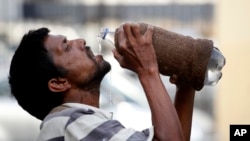Indian officials are launching a program to protect people from extreme heat in two high-risk regions, after a devastating heat wave killed at least 2,500 people across the country last year.
Already, India experiences severe heat waves almost every year. With climate change bringing higher temperatures, the country and its 1.25 billion people are bracing for even more challenging summers that will dry up forests, destroy crops, wipe out farm animals and kill hundreds if not thousands of people if they are not prepared.
"India is getting hotter, and it is killing people,'' said Anjali Jaiswal, India director for the New York-based National Resources Defense Council, which is helping local leaders and officials adopt the program.
It will be launched over the next week in Bhubaneshwar and three other cities in the eastern state of Orissa, as well as in the western temple town of Nagpur and four nearby cities where temperatures last year hit a sweltering 47 degrees Celsius (117 Fahrenheit), the NDRC said Wednesday.
It was rolled out in Ahmadabad in 2013, three years after some 1,200 people died from heat-related causes in the western city. Last year, after introducing seven-day weather forecasts, extra water supplies and cool-air shelters, only 20 people died in the city from the heat.
But altogether, the cities involved cover only about 11 million people _ not even 1 percent of the country's population.
"If you want to save lives you have to be prepared,'' Jaiswal said, calling on other Indian cities and regions to also adopt heat wave plans. "When it comes to protecting communities and people, it takes leadership.''
The cities involved in the program will now spend months preparing for summer by educating children about heat risk, stocking hospitals with ice packs and extra water, and training medical workers to identify heat stress, dehydration and heat stroke.
Many of those killed across the country last year, including more than 1,700 in the southern state of Andhra Pradesh, were day laborers, construction workers and farmers so poor they could not take a day off despite the heat.
Cities also plan to offer extra water supplies, cool-air shelters and afternoon breaks for workers.
The Indian Meteorological Department has revamped the way it forecasts temperatures and how it reports those forecasts to the country, to help officials plan for extreme events.
India's heat wave risk is exacerbated by its dwindling water resources, with increasingly erratic monsoon rains unable to deliver enough water to replenish heavily tapped rivers and plummeting groundwater reserves.
Experts have warned that by 2030, India will face an extreme water crisis. By that time, they say, the country will have only half the water supply necessary for agriculture, industry and people's needs.
"The monsoon was low last year, so we are worried about water availability when the temperatures start to rise,'' Jaiswal said.
India to Launch Heat Wave Programs in Vulnerable Cities

NEW DELHI —








